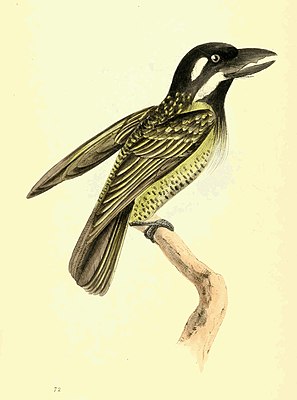Spotted Bearded Bird
| Spotted Bearded Bird | ||||||||||
|---|---|---|---|---|---|---|---|---|---|---|

Spotted bearded bird ( Tricholaema hirsuta ) |
||||||||||
| Systematics | ||||||||||
|
||||||||||
| Scientific name | ||||||||||
| Tricholaema hirsuta | ||||||||||
| ( Swainson , 1821) |
The spots Barbet ( Tricholaema hirsuta ) is a bird art from the family of African barbets. The species occurs in Africa. There are four subspecies. The IUCN classifies the spotted bearded bird as not endangered ( least concern ).
Appearance
The males of the nominate form have a wing length of 8.9 to 9.7 centimeters. The tail length is 4.4 to 5.1 centimeters. The beak reaches a length between 2.0 and 2.4 centimeters. Females have similar body measurements. The sexual dimorphism is not very pronounced. Females only have more yellow plumage.
The males of the nominate form have a blue-black head. The throat and chin are also blue-black. A thin white stripe runs down to the neck, a second white stripe runs from the base of the beak over the cheeks towards the neck. The top of the body is black with fine yellow spots. The control springs are black-brown. Freshly moulted, they have a fine yellow border. The spring shafts are horn-colored to white. The feathers on the black throat and on the yellow front breast have fine, long, hair-like black tips. The underside of the body is otherwise yellow with teardrop-shaped black spots. The beak is black, the featherless skin around the eyes is blackish gray, the eyes are red to reddish brown. Legs and feet are gray. Young birds resemble the adult birds, young females also have a more yellowish plumage early on. Overall, however, their plumage is even more dull than that of the adults.
The three other subspecies differ from the nominate form T. h. hirsuta mainly through the head drawing. T. h. flavipuntata has a more brownish head than T. h. hirsuta and the white stripes are missing. At T. h. ansorgii , the throat is whitish with fine elongated black spots. T. h. angolensis , the white head stripes are missing, the top of the head is dense yellowish mottled, the throat and cheeks are whitish with black elongated spots.
The spotted bearded bird is generally a very inconspicuous bird. It can be confused with the yellow-spotted bearded bird , but it lacks the red crown and the yellow facial markings as characteristic features of this species. The yellow-billed bearded bird has a longer tail and a yellow beak. In addition, unlike the spotted bearded bird, it rarely stays in tree tops.
Distribution area
The spotted bearded bird occurs from the south of Senegal via Sierra Leone and Liberia to Cameroon, the Central African Republic, the south of Sudan and Uganda to the west of Kenya. In a southerly direction its distribution area extends over Gabon, the VR Congo and the DR Congo to the north of Angola , from there over the south again the DR Congo and the northwest of Rwanda to Tanzania . It usually lives at altitudes below 1000 meters. In Uganda, however, it still occurs at altitudes of 1,800 meters.
Way of life
Spotted bearded birds predominantly colonize primary forests in the lowlands, but use older secondary forests if they are adjacent to primary forests . They look for food individually or in pairs. This distinguishes them from occurring in the same habitat Yellow Stain beard birds and grief barbets . They swallow fruits quickly, they look for insects in mosses and in crevices on branches or tree trunks. While foraging for food, they are mostly in the treetops, so that foraging takes place at a height of ten to 35 meters above the ground. Occasionally, however, they also use lower, fruit-bearing shrubs and trees, so that they come down to two meters above the ground. Fast movements and short flights between individual branches or lianas are typical for them.
The spotted bearded bird is a cave-breeder, he builds the tree holes he uses for his breeding business, presumably himself. Both sexes defend their territory. Its size is estimated at around twelve to 20 hectares per pair. The details of reproductive biology are largely unknown.
supporting documents
literature
- Lester L. Short, Jennifer FM Horne: Toucans, Barbets and Honeyguides - Ramphastidae, Capitonidae and Indicatoridae. Oxford University Press, Oxford 2001, ISBN 0-19-854666-1 .
Single receipts
- ↑ a b c Short et al., P. 174
- ↑ Short et al., P. 173
- ↑ Short et al., Color plate 4
- ↑ a b Short et al., P. 175
Web links
- Tricholaema hirsuta inthe IUCN 2013 Red List of Threatened Species . Listed by: BirdLife International, 2012. Retrieved February 2, 2014.